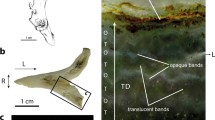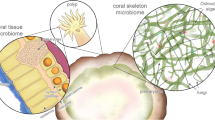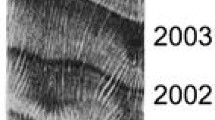Abstract
Fine-scale features of scleractinian skeletons were investigated in living colonies, from ultra-thin sections and SEM preparations. In contrast to what is commonly admitted, the coral fiber is a composite structure differing markedly from a simple aragonite crystal unit. The heterogeneity of coral fiber is shown by the occurrence of a micron-scale zonation resulting from incremental growth during elementary cycles of biomineralization. In addition, high magnification SEM reveals that a calcification center corresponds to a particular structural element clearly differentiated from the surrounding fibers and defined by its own crystal arrangement. The duality of this center/fiber arrangement corresponds to a general architecture of scleractinians, resulting from similar processes of skeletogenesis. An additional fine-scale diversity related to taxonomy is reflected by variations in the geometry and crystallinity of centers and also in the strength and regularity of fiber incremental zonation. These initial differences both within the same colony and between distinct taxa would be emphasized during diagenetic history, leading to differential susceptibility of structural elements to diagenetic processes and also to specific behavior of distinct taxa in relation to diagenesis.





Similar content being viewed by others
References
Allemand D, Tambutté E, Girard JP, Jaubert J (1998) Organic matrix synthesis in the scleractinian coral Stylophora pistillata: role in biomineralization and potential target of the organotin tributyltin. J Exp Biol 201:2001–2009
Alloiteau J (1957) Contribution à la systématique des Madréporaires fossiles. Edition CNRS, Paris, 449 pp
Barnes DJ (1970) Coral skeletons: an explanation of their growth and structure. Science 170:1305–1308
Barnes DJ (1972) The structure and formation of growth ridges in scleractinian coral skeletons. Proc R Soc Lond Ser B 182:331–350
Bevelander G, Nakahara H (1980) Compartment and envelope formation in the process of biological mineralization. In: Omori M, Watabe N (eds) The mechanisms of biomineralization in animals and plants. Proc 3rd Int Biomineralization Symp, Tokai University Press, Tokyo, pp 19–27
Bryan WH (1941) Spherulites and allied structures. Proc R Soc Queensl LII(1):41–53
Bryan WH, Hill D (1941) Spherulitic crystallization as a mechanism of skeletal growth in the hexacorals. Proc R Soc Queensl LII(1):78–91
Constantz B (1985) Taxon-specific diagenetic variation among scleractinian corals (Barbados, West Indies). Proc 5th Int Coral Reef Symp 2:86–92
Constantz B (1986a) Coral skeleton construction: a physiochemically dominated process. Palaios 1:152–158
Constantz B (1986b) The primary surface area of corals and variations in their susceptibility to diagenesis. In: Schroeder JH, Purser BH (eds) Reef diagenesis. Springer, Berlin Heidelberg New York, pp 53–76
Constantz B (1990) Skeletal organization in Caribbean Acropora spp. (Lamarck). In: Crick RE (ed) Origin, evolution and modern aspects of biomineralization in plants and animals. Plenum Press, New York, pp 175–199
Constantz B, Meike A (1990) Calcite centers of calcification in Mussa angulosa (Scleractinia). In: Crick RE (ed) Origin, evolution and modern aspects of biomineralization in plants and animals. Plenum Press, New York, pp 201–207
Constantz B, Weiner S (1988) Acidic macromolecules associated with the mineral phase of scleractinian coral skeletons. J Exp Zool 248:253–258
Cuif JP, Dauphin Y (1998) Microstructural and physico-chemical characterization of 'centres of calcification' in septa of some Recent scleractinian corals. Palaeontol Z 72:257–270
Cuif JP, Perrin C (1999) Micromorphology and microstructure as expressions of scleractinian skeletogenesis in Favia fragum (Esper, 1795) (Faviidae, Scleractinia). Zoosystema 21(2):1–20
Dauphin Y, Perrin C (1992) Mise en évidence de la présence de matière organique dans un ciment d'aragonite botryoidale par spectrométrie infrarouge à transformée de Fourier (FTIR). Neues Jahrb Geol Palaeontol 186(3):301–319
Duerden JE (1904) Recent results on the morphology and development of coral polyps. Smithson Misc Collect 47:93–111
Dullo WC (1986) Variation in diagenetic sequences, an example from Pleistocene coral reefs, Red Sea, Saudi Arabia. In: Schroeder JH, Purser BH (eds) Reef diagenesis. Springer, Berlin Heidelberg New York, pp 77–90
Gautret P, Marin F (1993) Evaluation of diagenesis in scleractinian corals and calcified demosponges by substitution index measurement and intraskeletal organic matrix analysis. Cour Forsch-Inst Senckenberg 164:317–327
Hayasi K (1937) On the detection of calcium in the calicoblasts of some reef corals. Palao Trop Biol Sta Stud 2:169–176
Houck JE, Buddemeier RW, Chave KE (1975) Skeletal low-magnesium calcite in living scleractinian corals. Science 189:997–999
Isa Y (1990) Calcium binding substance in the hermatypic coral, Acropora hebes (Dana). In: Crick RE (ed) Origin, evolution and modern aspects of biomineralization in plants and animals. Plenum Press, New York, pp 167–174
Jell JS (1974) The microstructure of some scleractinian corals. Proc 2nd Int Coral Reef Symp Great Barrier Reef Committee 2:301–320
Jell JS, Hill D (1974) The microstructure of corals. In: Sokolov BS (ed) Ancient Cnidaria. Acad Sci USSR Trans Inst Geol Geophys 201(1):8–14
Johnston IS (1977) Aspects of the structure of a skeletal organic matrix and the process of skeletogenesis in the reef-coral Pocillopora damicornis. Proc 3rd Int Reef Symp 2:447–453
Johnston IS (1980) The ultrastructure of skeletogenesis in hermatypic corals. Int Rev Cytol 67:171–214
Krempf A (1907) Sur la formation du squelette chez les hexacoralliaires à polypier. C R Acad Sci D 144:157–159
Lowenstam HA, Weiner S (1989) On biomineralization. Oxford University Press, New York, 324 pp
Macintyre IG, Towe KM (1975) Skeletal calcite in living scleractinian corals: microboring fillings, not primary skeletal deposits. Science 193:701–702
Mitterer RM (1978) Amino acid composition and metal binding capability of the skeleton protein of corals. Bull Mar Sci 28:173–180
Mutvei H (1980) The nacreous layer in molluscan shells. In: Omori M, Watabe N (eds) The mechanisms of biomineralization in animals and plants. Proc 3rd Int Biomineralization Symp, Tokai University Press, Tokyo, pp 49–56
Ogilvie MM (1896) Microscopic and systematic study of madreporian types of corals. Phil Trans R Soc Lond B 787:83–345
Perrin C, Cuif JP (2001) Ultrastructural controls on diagenetic patterns of scleractinian skeletons: evidence at the scale of colony life-time. Proc 8th Int Symp Fossil Cnidaria and Porifera, Bull Tohoku Museum 1:201–209
Ramseyer K, Miano TM, d'Orazio V, Wildberger A, Wagner T, Geister J (1997) Nature and origin of organic matter in carbonates from speleothems, marine cements and coral skeletons. Org Geochem 26:361–378
Simkiss K, Wilbur KM (1989) Biomineralization: cell biology and mineral deposition. Academy Press, San Diego, 337 pp
Sorauf JE (1970) Microstructure and formation of dissepiments in the skeleton of the recent Scleractinia (hexacorals). Forsch Biomineral 2:1–22
Sorauf JE (1972) Skeletal microstructure and microarchitecture in Scleractinia (Coelenterata). Palaeontology 15:88–107
Sorauf JE (1980) Biomineralization, structure and diagenesis of the coelenterate skeleton. Acta Palaeont Polon 25(3–4):327–343
Sorauf JE (1993) The coral skeleton: analogy and comparisons, Scleractinia, Rugosa and Tabulata. Cour Forsch-Inst Senckenberg 164:63–70
Sorauf JE (1996) Biocrystallization models and skeletal structure of Phanerozoic corals. In: Stanley GD Jr (ed) Paleobiology and biology of corals. Paleontol Soc Pap 1:159–185
Sorauf JE, Jell JS (1977) Structure and incremental growth in the ahermatypic coral Desmophyllum cristagalli from the North Atlantic. Palaeontology 20(1):1–19
Towe KM (1972) Invertebrate shell structure and the organic matrix concept. Biomin Res Rep 4:1–14
Wainwright SA (1963) Skeletal organization in the coral Pocillopora damicornis. Q J Microscop Sci 104:169–183
Wainwright SA (1964) Studies on the mineral phase of coral skeletons. Exp Cell Res 34:213–230
Weedon MJ, Taylor PD (1995) Calcitic nacreous ultrastructures in bryozoans: implications for comparative biomineralization of lophophorates and molluscs. Biol Bull 188:281–292
Wilbur KM (1976) Recent studies of invertebrate mineralization. In: Watabe RE, Wilbur KM (eds) The mechanisms of mineralization in the invertebrates and plants. University of South Carolina, Columbia, pp 79–108
Wilbur KM (1980) Cells crystals and skeletons. In: Omori M, Watabe N (eds) The mechanisms of biomineralization in animals and plants. Proc 3rd Int Biomineralization Symp, Tokai University Press, Tokyo, pp 3–11
Young SD (1971) Organic material from scleractinian coral skeletons, I. Variation in composition in between several species. Comp Biochem Physiol 40B:113–120
Young SD, O'Connor JD, Muscatine L (1971) Organic material from scleractinian coral skeletons, II. Incorporation of 14C into protein, chitin and lipid. Comp Biochem Physiol 40B:945–958
Acknowledgements
I am grateful to Drs. D. Buigues and B. Gout (CEA), Dr. M. Guillaume and Prof. D. Doumenc (Laboratoire de Biologie des Invertébrés Marins, MNHN, Paris) for providing scleractinian colonies. Lionel Merlette, Michel Lemoine, and Christiane Chancogne (Laboratoire de Paléontologie, MNHN, Paris) are especially thanked for technical and research assistance with the preparation of coral specimens and SEM. Bernard Riegl, Peter Swart, and an anonymous reviewer are thanked for their comments which helped in improving the manuscript. This work was supported by the Programme National sur les Récifs Coralliens (PNRCO) and the Programme National sur les Environnements Côtiers (PNEC).
Author information
Authors and Affiliations
Corresponding author
Rights and permissions
About this article
Cite this article
Perrin, C. Compositional heterogeneity and microstructural diversity of coral skeletons: implications for taxonomy and control on early diagenesis. Coral Reefs 22, 109–120 (2003). https://doi.org/10.1007/s00338-003-0291-8
Received:
Accepted:
Published:
Issue Date:
DOI: https://doi.org/10.1007/s00338-003-0291-8




